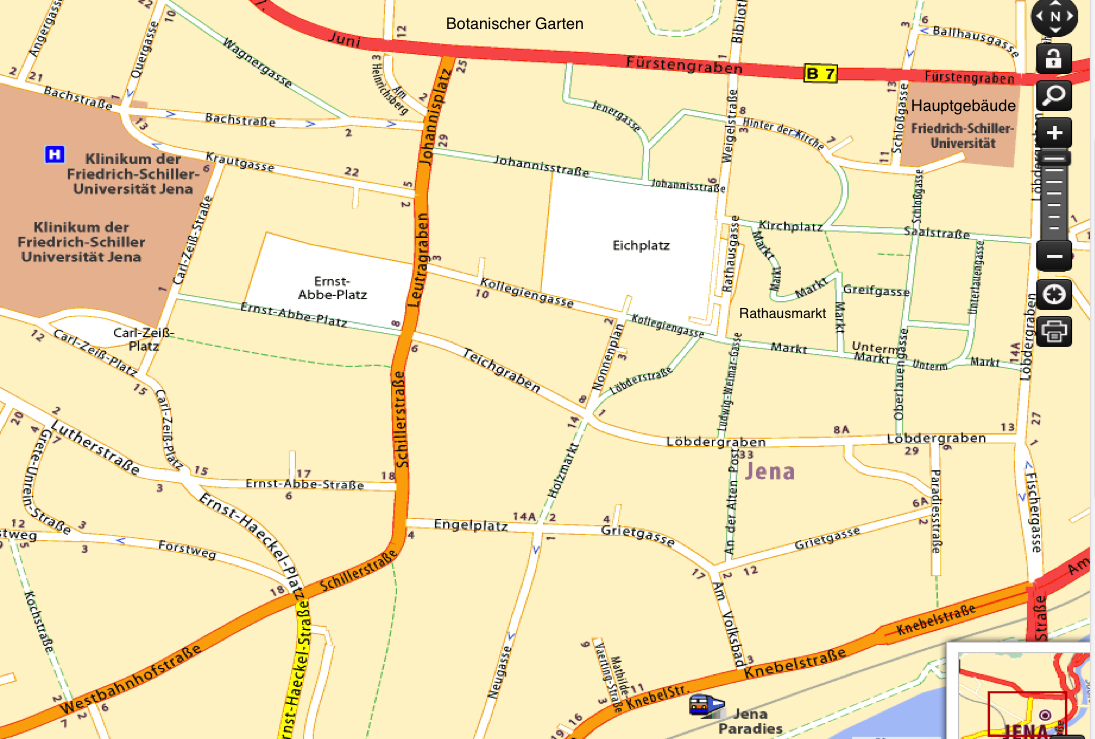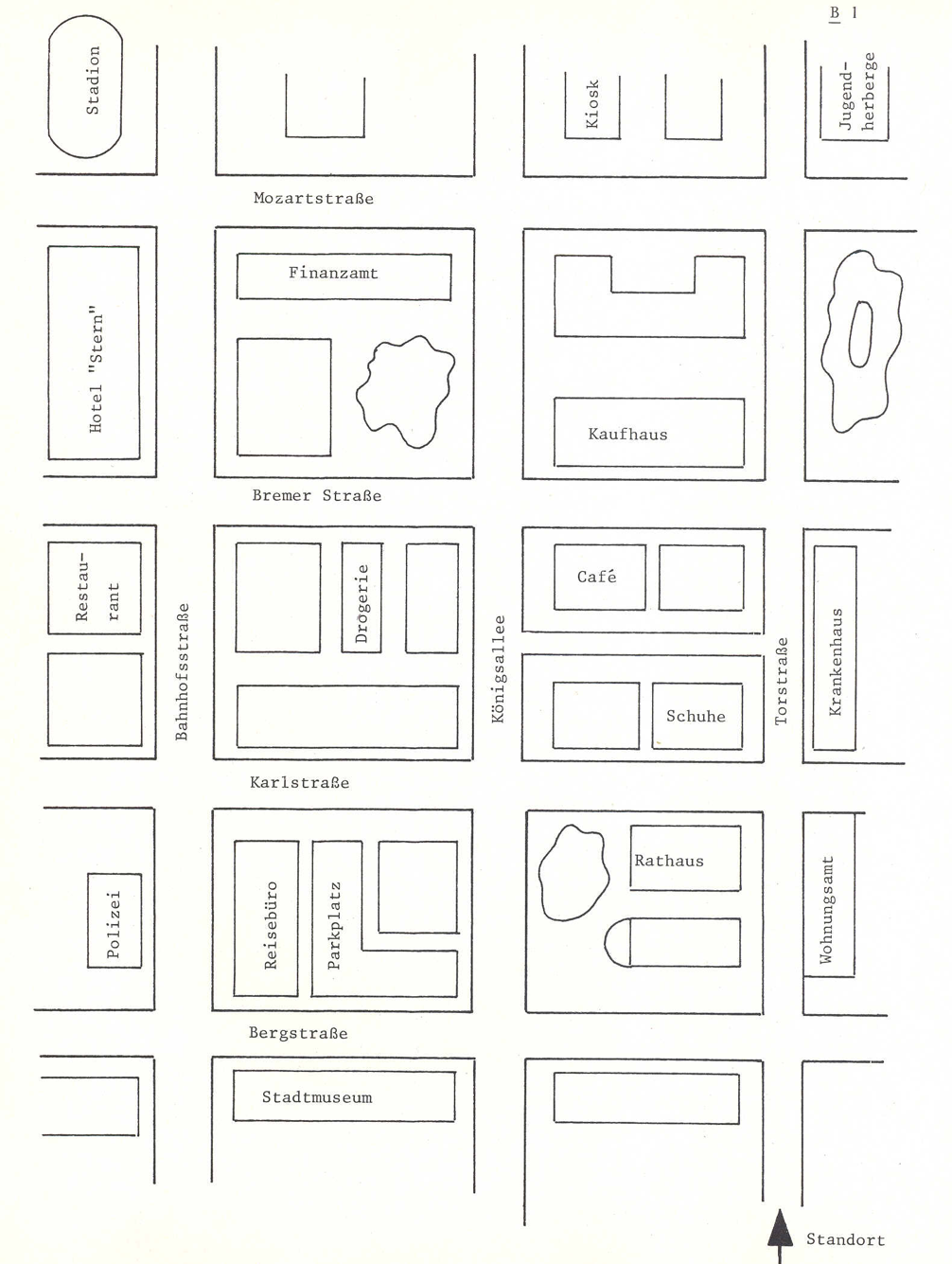| Seite 11 |
Übung 7-3a Survival German: Wegbeschreibung: Asking and Giving Directions
Wegbeschreibungen: Sie stehen da, wo der Pfeil ist. Fragen Sie Ihren Partner nach dem Weg! (You are standing at the arrow. Ask your partner for directions!)
Here are the places where you need to go:
|
Übung 7-7b Feiertage und Geburtstage (Teil B; Teil A ist auf Seite 7) Ask your partner when they have their birthdays, then ask when the holidays are celebrated. NOTE: In the USA we write dates month/day/year. In Germany and other countries they write dates day.month.year: May 11, 1997 is in German: 11.05.1997.
- Wann hast du Geburtstag? Am elften Mai.
- Wann hast du Geburtstag gehabt? Am zweiundzwanzigsten Februar.
- Wann ist Mariä Himmelfahrt? Am fünfzehnten August.
- Wann war Karfreitag? Am fünfundzwanzigsten März.

Meine Partnerin / Mein Partner hat Geburtstag _____________________
_____ Neujahr
19.04 Karfreitag
_____ Ostermontag
01.05 Tag der Arbeit
____ Christi Himmelfahrt
06.06 Pfingstmontag
_____ Tag der Deutschen Einheit
31.10 Reformationstag
_____ der erste Weihnachtstag
26.12 der zweite Weihnachtstag
_____ Valentinstag
04.03 Rosenmontag
_____ Fastnacht
06.03 Aschermittwoch
_____Palmsonntag
22.04 Ostersonntag
Übung 7-8a: Über Weihnachtseinkäufe sprechen 3 Teil B (Teil A ist auf Seite 8) Review of dative case, present perfect tense, and adjective endings.

Was hast du deinen Eltern geschenkt? Was hast du deinem Bruder gekauft? Was hast du deiner Freundin gegeben?
| Sie | ||||||
|---|---|---|---|---|---|---|
| Ihre Partnerin / Ihr Partner |
Übung 7-8c: Neu in Jena Teil B. (Teil A ist auf Seite 8) Sie sind eine neue Studentin oder ein neuer Student in Jena. Wie finden Sie Ihren Weg?
- Wie komme ich von dem Bahnhof "Jena Paradies" zum Hauptgebäude der Uni?
- Wie komme ich von dem Hauptgebäude der Uni zur Wagnergasse?
- Wie komme ich von der Wagnergasse zum Karl-Zeiß-Platz?
- Wie komme ich vom Karl-Zeiß-Platz zum Botanischen Garten?
- Wie komme ich vom Botanischen Garten zum Rathausmarkt?
- Wie komme ich vom Rathausmarkt zum Ernst-Abbe-Platz?
Find all the locations on the city map and determine how to give directions in German. (See "Seite 3".) Take turns using a game piece and move it on the map according to the directions your partner gives.

-
- Gehen Sie rechts in Hinter der Kirche.
Biegen Sie links in die Weigelstraße ab.
Gehen Sie noch eine Straße, dann biegen Sie rechts in die Johannisstraße ab.
'Gehen Sie die Johannisstraße entlang zum Johannisplatz. Dann gehen Sie gleich links in die Bachstraße.
Die Wagnergasse ist die erste Straße rechts.
-
- Gehen Sie die Carl-Zeiß-Straße entlang zum Ernst-Abbe-Platz. Biegen Sie rechts in den Ernst-Abbe-Platz ab.
Dann gehen Sie zum Leutragraben und biegen Sie links in den Leutragraben ab.
Gehen Sie an der Kollegienstraße und an der Johannisstraße vorbei. Leutragraben wird Johannisplatz.
Gehen Sie über den Fürstengraben. Da steht der Botanische Garten.
-
- Gehen Sie rechts in die Kollegiengasse und gehen Sie an dem Eichplatz vorbei zum Leutragraben. Gehen Sie über den Leutragraben und der Ernst-Abbe-Platz liegt rechts.
Test Kapitel 7 The Test is posted on BOLT under "Quizzes" and the speaking section is posted on BOLT under "Assignments".
- Hörverständnis
- Hörverständnis: vocabulary
- Hörverständnis: audio file
- Wer hat wem etwas gegeben? Beispiel: (use "geben") Manfred hat seinem Bruder einen neuen (neu) Mantel gegeben.
- Kausal- und Konditionalsätze. Logical or illogical?
- Kausal- und Konditionalsätze. For each pair of statements, construct a conditional or a causal statement. If "second" is indicated, then the conditional/causal statement is the second clause. If "first" is indicated, then the conditional/causal statement is first. Beispiel: Wir werden nicht zum Strand gehen. Es regnet. (because, second) → Wir gehen nicht zum Strand, weil es regnet. / (if, first) Wenn es regnet, gehen wir nicht zum Strand.
- Womit? Damit! Mit wem? Mit ihr! Da-compounds and pronouns. Translate the English Sentences into parentheses into German. Beispiele: Ist der Bus schon gekommen? (No, we are still waiting for it.) → Nein, wir warten noch darauf. / Ist der Professor schon gekommen? (No, we are still waiting for him.) → Nein, wir warten noch auf ihn.
- Choose the correct translation that uses the correlative construction. Beispiel: We are working on getting more money. → (correct answer) Wir arbeiten daran, dass wir mehr Geld bekommen.
- Ask a question about the italicized element. USE A LOGICAL PRONUOUN in your answers! Beispiele: Wir fragen nach dem Weg. → Wonach fragt ihr? Du hast nach deinem Bruder gefragt. → Nach wem habe ich gefragt?
- Adjective endings. Fill in the blanks with the endings for adjectives, definite articles, indefinite articles and personal adjectives.
- Speaking. Giving Directions.
- The speaking section is posted on BOLT under "Assignments".
- Record your voice giving directions using the recording tool in BOLT.
- Before beginning, write out the directions, then copy and paste the text in Natural Readers.
- Then practice, imitating the spoken text, until fluent and as accurate as possible.
- This section counts 15% of the chapter test.
